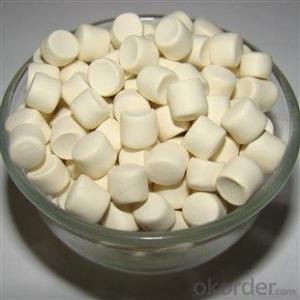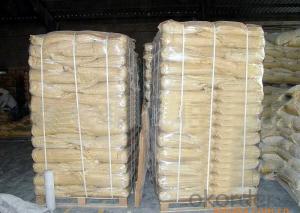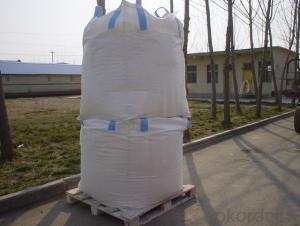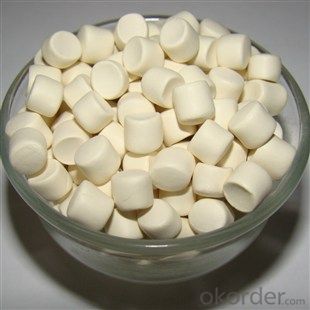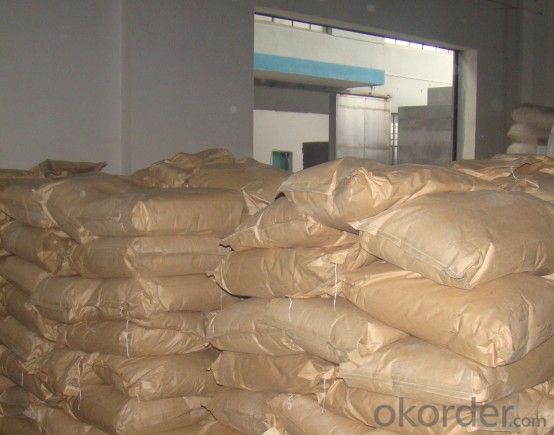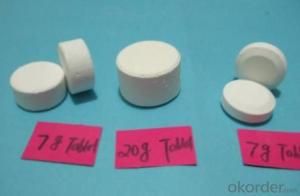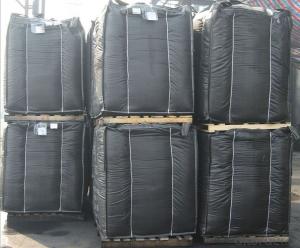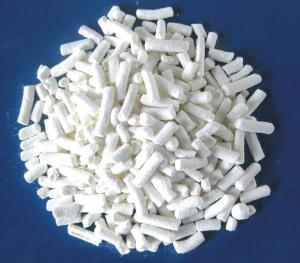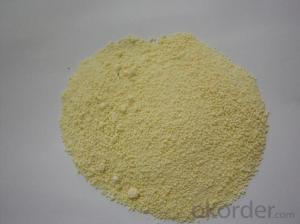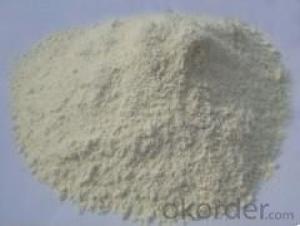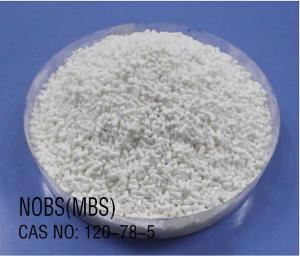Rubber Chemicals RUBBER VULCANIZING ACCELERATOR MBT (M)
- Loading Port:
- Tianjin
- Payment Terms:
- TT or LC
- Min Order Qty:
- 25 m.t.
- Supply Capability:
- 12000 m.t./month
OKorder Service Pledge
OKorder Financial Service
You Might Also Like
RUBBER VULCANIZING ACCELERATOR MBT(M)
Chemical Name:2-Mercaptobenzothiazole
Molecular Formula:C7H5NS2
Molecular Weight: 167.26
CAS NO. : 149-30-4
Executive standard:GB/T 11407-2003
Specification:
| Index | ||
High-class products | First-class products | Acceptable end-product | |
Appearance(Visual nspection) | Light yellow or greyish-white powder, granules | ||
Initial M.P, oC ≥ | 173.0 | 171.0 | 170.0 |
Loss on drying, % ≤ | 0.30 | 0.40 | 0.50 |
Ash, % ≤ | 0.30 | 0.30 | 0.30 |
Residues on 150μm sieve,% ≤ | 0.00 | 0.10 | 0.10 |
Properties:
It is Light yellow or off-white powder, granules with a little osmyl and taste bitter. The density is 1.42-1.52, Melting point above 171oC,Soluble in ethyl acetate, ethanol, solution of NaOH and baking soda,soluble ethanol ,dichloromethane,ethylether and choroform slightly soluble in benzene, insoluble water and gasoline. Good storage stability. lower explosion limit is 21g/m3.
Application:
Used as an acid accelerator currently and a medium fast primary accelerator. Imparts excellent aging properties when used both alone and in combination with DM, TMTD and many other basic accelerators for higher activity. Its accelerative temperature is low and easily be dispersed with lower pollution. Mainly used in the manufacture of tires, tubes, foot wear rubber belts and hoses etc.
Packaging:
25kg plastic woven bag, paper with plastic film bag, Kraft paper bag or jumbo bag
Storage:
Keep container tightly closed in a cool, well-ventilated place. The recommended max.
storage life is 2 years when stored under normal conditions.
The product could be ultra fine powder based on customer accurate quirement.
- Q: When there is a catalyst in the chemical equation, it is not necessary to match the atoms of the catalyst
- No, the catalyst is written above the equal sign, not the reactants, nor the product
- Q: The "one-to-two change" of the catalyst is that the quality and chemical properties of the reactants are constant or the quality and chemical properties of the catalyst are constant?
- The morphology of the catalyst may change before and after the chemical reaction, but the quality and chemical properties of the chemical reaction do not change before and after the chemical reaction. It is noteworthy that this does not mean that the catalyst is not involved in chemical reactions. Some chemical catalysts are involved in chemical reactions, but in the form of intermediates, consume a certain amount of catalyst in a chemical reaction, but in the subsequent chemical reactions, the same quality of the catalyst will be produced. On the whole, the quality of the catalyst before and after the chemical reaction is not changed.
- Q: Explain how a catalyst may increase the rate of chemical reaction?
- A catalyst lowers the acitvation energy of a reaction.
- Q: I opened catalyst control center to see what its was, i didn't change anything and now when i full screen a youtube and hulu the screen will be black and the loading bar at the bottom will be stuck. I also noticed that now when i play minecraft all the blocks have a black out line i cant get rid of. I tried deleting my .minecraft and that didn't fix it.
- Catalyst control center? You, my friend, have a Radeon graphics card. What's happening is that somewhere you have Anti-Aliasing turned on. Go back into your catalyst control center and anywhere where there is an option to 'use application settings'- select it. It's supposed to improve your graphics quality, but there are a lot of bugs with it on a whole bunch of applications and games- including Minecraft. Oh, and as for the youtube thing- alt+tab should show you where your video has disappeared to. Yes, I know- it's bloody weird, but flash is buggy as heck, and Radeon graphics cards are weird; I should know- I have one too! That should do the trick! If it doesn't work then there's likely an extra option somewhere that you haven't ticked to 'use application settings'.
- Q: Could God be Discribed as a Catalyst?
- I'm an atheist but one of my friends explained that thinking to me. Here's what he said. Do objects exist? When objects are created something creates them, right? Objects can't be created from themselves. (Chicken and Egg theory) There needs to be a catalyst for things to be created. I just choose to label this catalyst by the name of God. Technically my friend went into a lot more detail but I don't really remember his exact words. Hope this helps.
- Q: Will the catalyst change in the chemical reaction?
- The catalyst is actually involved in the chemical reaction, the catalyst is added to the reaction, becomes the other material, and then the reaction becomes back, and appears to have no change, actually involved in the change, but the end result the catalyst did not change
- Q: What is the difference between biological and chemical catalysts?
- Biological catalysis involves an enzyme usually working in conjunction with a co-enzyme. These enzyme/co-enzyme systems are highly specific and are usually only effective for one reaction. Catalysis of non biological reactions is usually much more general and any one catalyst will be effective in many reactions.
- Q: hey people i need your help about my science lab report...the question on my paper says "what function the catalyst?....please help me on this one...i would really appreciate if you leave me answers....much mahalos to all you folkss...thanks
- A catalyst is a substance used to change the rate of a reaction. If it increases, it is posititve catalyst . Decreases means negative catalyst. If the reactants and catalyst are in same phase, it is homogenous catalysis, otherwise heterogenous. Any reaction to occur, the reactants have to combine to form an intermediate compound and then to product. This requires surpassment of a minimum amout of energy known as Ea- Activation energy. Catalyst decreased the Ea, so that , passing the barrier becomes easy and hence the speeding of the reaction.
- Q: Chemical reaction in the presence of catalyst for the reaction are carried out a high life
- Some reactions require some of the catalyst that is not needed
- Q: woulld you be able to answer these aswell i really dont know how to do this cehmestryExplain how, and why, an atom of chlorine (Cl) and an atom of lithium (Li) would form a chemical bond with each other. (iii)Explain what is meant by electronegativity and how it can be used to determine the nature of a chemical bond. (iv)Write a note outlining what is meant by vapor pressure and explain how the concept is used to define the boiling point of a liquid.
- Because of the production of photochemical oxidants from NOx reacting with hydrocarbons in sunlight Noxer blocks are used to rid the NOx from the surroundings through The titanium dioxide (TiO2) on the bocks absorbs ultra-pink radiation from daylight which excites its electrons to a bigger orbital. On the outside of the crystals of TiO2 a reaction happens between oxygen and a high power electron from the TiO2. O2 + e? --O2 ? The excessive vigor electron is then given back to the TiO2 when water then reacts with the oxygen to present H2 O + O2 --H+ + O2 ? + OH Nitrogen dioxide is oxidised to nitrate ions as a result of the hydroxyl radical being an awfully strong oxidising agent NO2 + OH --H+ + NO3 ? The superoxide from response 3 also varieties nitrate ions from nitrogen monoxide. NO + O2 ? --NO3 ? This nitrate is washed away through rain or combines with the concrete within the block.
Send your message to us
Rubber Chemicals RUBBER VULCANIZING ACCELERATOR MBT (M)
- Loading Port:
- Tianjin
- Payment Terms:
- TT or LC
- Min Order Qty:
- 25 m.t.
- Supply Capability:
- 12000 m.t./month
OKorder Service Pledge
OKorder Financial Service
Similar products
Hot products
Hot Searches
Related keywords
